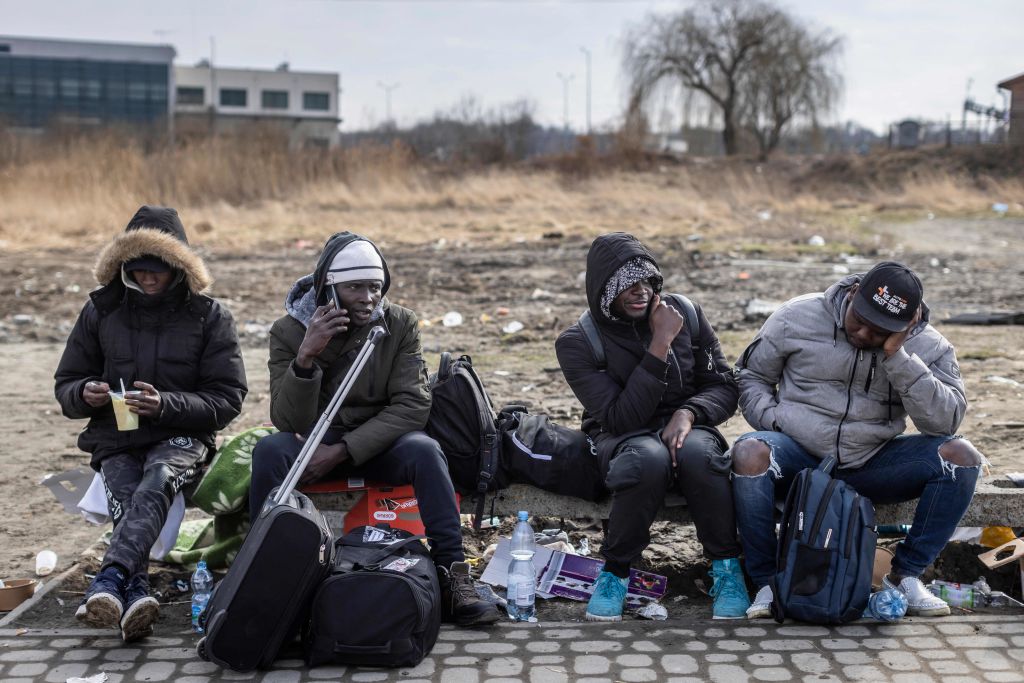The Ukrainian Refugee Crisis’ Double Standard
Watching the war unfold in Ukraine due to the recent Russian invasion, I, like many others, have been gripped by heartbreaking images of refugees arriving to the borders of other countries by the hundreds of thousands: Their clothes soaked by the cold rain, their shoes worn through the soles by the miles walked, and their children hungry, exhausted, and scared as they cling to the one cherished toy they carried with them all those miles.
As an anthropologist and filmmaker who focuses on human rights and global migration, these images of humans in desperate need of asylum are intimately familiar to me.
What wasn’t familiar to me were the heartwarming responses from Polish citizens lining up at the border to donate clothes and shoes. I couldn’t believe the images of cars queuing to offer free rides or of train station platforms where rows of strollers sat awaiting Ukrainian mothers who might arrive with tired arms. I even saw border guards handing out warm meals to refugees waiting to hear which reception center would be available to house them.
Over a month into the conflict with Russia, the number of Ukrainian refugees now tops 4.3 million, making it the fastest growing exodus of people Europe has seen since World War II. The numbers have surpassed the worst-case scenario estimated by the United Nations Refugee Agency (UNHCR).
But long before Ukraine took center stage, refugee crises have been ongoing in many parts of the world. As of 2021, UNHCR reported 6.6 million Syrians had fled the ongoing Syrian Civil War. Around 3.4 million Afghans are currently displaced—including hundreds of thousands following the U.S. military’s sudden withdrawal from the country last summer. And according to the Africa Center for Strategic Studies, an estimated 32 million people across the African continent are displaced. The nongovernmental organization Caminando Fronteras reported 4,404 African and Middle Eastern refugees died in 2021 alone while attempting to cross the Mediterranean Sea on their way to Spain—a harrowing average of 12 people per day.
As part of my work, I’ve had the privilege of documenting countless refugee journeys—mothers from Syria to the Democratic Republic of Congo to Venezuela who share a common courage as they gather what little they can carry on their backs and brave increasingly difficult journeys in order to bring their children to safer ground.
I’ve also documented the reception these women and children receive when their journeys finally reach the end. Instead of a welcome, they’re often greeted by armed border patrols ready to detain and deport them, and by citizens who protest new refugee arrivals—waving signs with slogans like “Go Home” and “Secure Our Borders.”
How can we make sense of this double standard: the sympathy authorities and ordinary citizens have extended to Ukrainian refugees compared to the harsh treatment given to those fleeing conflict in other parts of the world?
Only days into Russia’s invasion, the European Union approved an emergency plan granting any Ukrainian citizen or family member of a Ukrainian citizen the right to live and work in the bloc for up to three years. The plan waives all special visa requirements and allows Ukrainian refugees to bypass the lengthy applications and other bureaucratic hurdles that often make the asylum system challenging to navigate.
Reading this news, I couldn’t help but think that 74 years after the Universal Declaration of Human Rights was signed into law in Paris, the document is still hard at work. It was created to provide security to the millions of men, women, and children who were forcibly displaced by World War II. Today it promises that same security to those who have been forced to flee Ukraine.
More than half of those fleeing Ukraine have been received by Poland, and Moldova, Romania, Slovakia, and Hungary have also set up new reception centers for Ukrainian refugees. But this warm welcome of refugees is the exception, not the rule, for most European countries.
Take Hungary, for example, whose right-wing government has developed a reputation for firmly shutting its doors to those fleeing conflict in recent years. Only two months ago, Prime Minister Viktor Orbán claimed Hungary would not change its strict new immigration policies, despite a ruling from the European Union’s highest court that found the country in direct defiance of the bloc’s refugee and asylum laws. “We aren’t going to let anyone in,” Orbán stated. Recently, however, he said Ukrainians could expect to find a “friendly place” awaiting them in Hungary.
The reasons for this double standard, not surprisingly, seem to boil down to a mix of racism, Islamophobia, and xenophobia. Anthropologists and others have long pointed to the structural inequities in how human rights law is applied to migrants, refugees, and asylum-seekers. Decisions are heavily mediated by race and nationality, in addition to other factors such as religion, gender, and age. In short: The international legal system too often allows discrimination and exclusion rather than ensuring unbiased protection to those in need of refuge.
Bulgarian Prime Minister Kiril Petkov was one of the first public figures to explicitly differentiate between those fleeing Ukraine and those fleeing other countries. “These people are Europeans,” he said. “These people are intelligent, they are educated people. … This is not the refugee wave we have been used to, people we were not sure about their identity, people with unclear pasts, who could have been even terrorists.”
Media reporting since the beginning of Russia’s war on Ukraine has revealed similar prejudices. “This isn’t a place, with all due respect, you know, like Iraq or Afghanistan that has seen conflict raging for decades,” said Charlie D’Agata, senior foreign correspondent for CBS News, speaking to audiences from a street in Kyiv. “You know, this is a relatively civilized, relatively European … city.” (He later apologized for these statements.)
News anchors on BFM TV in France echoed these sentiments: “We are in the 21st century, we are in a European city, and we have cruise missile fire as though we were in Iraq or Afghanistan, can you imagine?” Reporters on ITV in the U.K. bluntly said: “This is not a developing Third World nation. This is Europe.”
Such rhetoric makes clear to audiences that White, Christian Europeans are seen as more worthy of safety than those fleeing the Middle East or Africa. It also reveals underlying assumptions about who can justifiably be forced to live with war and violence.
Despite the E.U. opening its gates to Ukrainians, not all of those fleeing the war-torn country have been met with open arms.
Ukraine is home to 76,000 foreign university and graduate students from Africa, the Middle East, and Asia who are now Ukrainian refugees too. Yet shortly after the fighting erupted, reports began surfacing of Black people who were fleeing Ukraine being refused places on trains and pushed back at border crossings. “They’re not letting the Black girl go!” says an onlooker in one video that captures the disquieting moment when a young woman is prevented from boarding an evacuation train.
The African Union was quick to release a statement saying the organization is “particularly disturbed by reports that African citizens on the Ukrainian side of the border are being refused the right to cross the border to safety” and that, if true, these reports would not only “be shockingly racist” but a “breach [of] international law.” The chairpersons reminded the world that “all people have the right to cross international borders during times of conflict.”
One only needs to travel south from Poland to Spain to see that even as new reception centers are being constructed in Hungary to house Ukrainian refugees, there are many places where the European Union’s gates remain firmly closed.
In the same week that a record number of refugees were welcomed across European countries and standard background checks were waived in favor of warm meals, the very small number of asylum-seekers who made it across Europe’s southernmost borders into the Spanish enclaves of Ceuta and Melilla were violently beaten back into Africa—even the minors who were among them. They were never given the chance to share their names, their ages, or the reasons they were fleeing.
At these borders, little attention is being paid to international laws guaranteeing all humans the basic right to seek asylum.
One image that has stuck with me these past weeks is of a wrinkled piece of paper I saw distributed to refugees arriving at the border between Ukraine and Slovakia. It states: “The Slovak Republic provides Temporary Protection to citizens of Ukraine and to family members of citizens of Ukraine.” Available in multiple languages, it clearly outlines the rights that will be granted to refugees: accommodation, food, work opportunities, health care, and hygiene packages—immediately and free of charge.
I want to envision a world where asylum-seekers from across the Middle East and Africa who have fled violent conflict and survived impossible journeys are greeted at Europe’s borders with a list of their rights instead of with the rubber bullets and batons of patrolling officers.
We can learn a lot from this current moment—from both the shining examples of humanity seen across Europe and the exposure of racist and Islamophobic structures that underly our asylum system.
https://twitter.com/katymfallon/status/1500760187690536962?ref_src=twsrc%5Etfw
Europe’s Ukrainian response is boldly dismantling the excuses often given to justify stricter immigration policies in recent years: limited space, constrained budgets, and a lack of cooperation needed to fulfill their international human rights obligations. The current refugee relief effort is estimated to cost upward of US$30 billion in its first year alone, but European countries are stepping up to meet this financial and logistical challenge. If the global public sees that there is in fact the political will to act when needed, then we must also see that the E.U. is choosing which lives are worth the effort and resources needed to protect them.
This shift is happening because politicians, authorities, and ordinary citizens are making the choice to see strangers as human beings: as people not so different from themselves, save the extraordinary circumstances they find themselves in. They are asking: What reception would I want, if I was the one who was forced to flee? It’s a simple yet incredibly powerful shift away from the politicization of and toward the humanization of refugees.
This tragedy has shown how our international laws can function—and were in fact meant to function—to serve those who no longer have a safe place to call home. This is the moment for us, as nations and as individuals, to challenge ourselves to see the welcoming of Ukrainian refugees not as the exception—but as the new standard for all refugees.

































